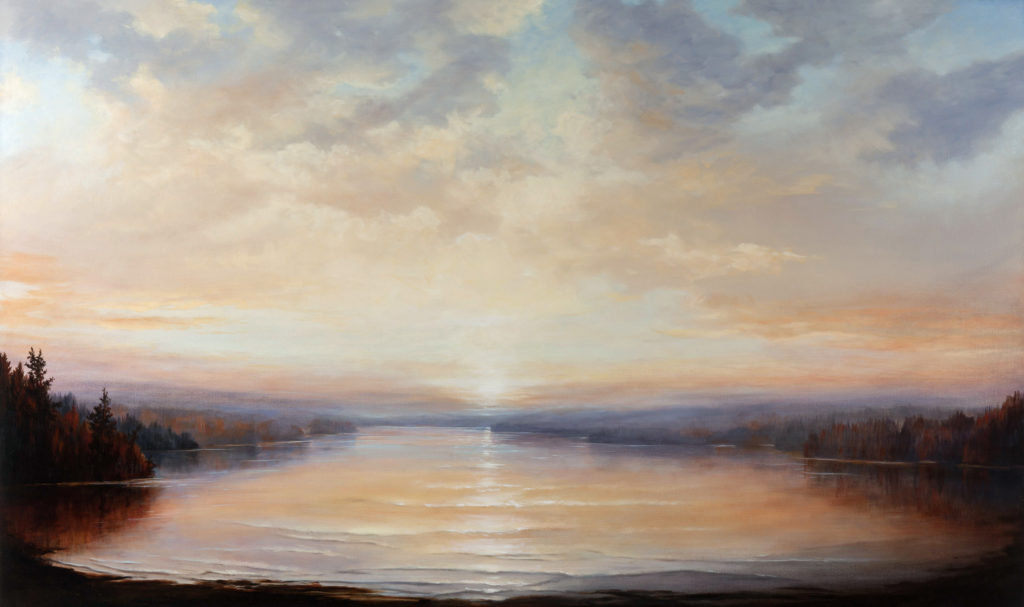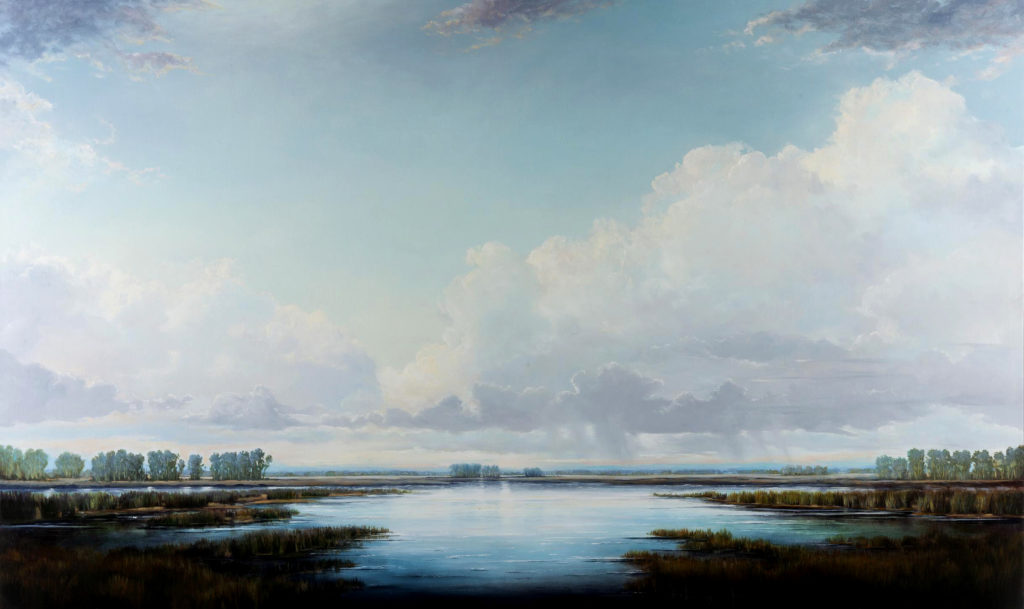Fine Art Today had a compelling conversation with an amazing landscape painter, who gave us detailed insight into her creative goals and processes that deserve quotation in full. You’re invited to bask in her tranquil illumination. Do you know her yet?

Fine Art Today: Tell me a little about your creative process. Once inspiration hits, how do you approach the panel/canvas? In other words, do you always start a piece the same way even if the sources of inspiration are different? How do you know when a painting is completed; is it that sense of personal fulfillment, or that a particular experience/idea is re-achieved?
Victoria Adams: All of my paintings include large areas of stormy sky above either a landscape or a waterscape. The scenes are fictional, generated entirely from my imagination or constructed from the memory of an actual scene and its details. Or sometimes a scene emerges from a combination of these techniques. My canvases are completed wholly in my studio, but they do include many details from the real world. During the process of painting, I usually rely on segments of multiple photographs that I take during walks or trips. I render fragments and details from these photos of skies, water, land features, trees, etc. in each painting in order to give my imagined or remembered scenes a greater illusion of representational truth.
My works range in size from very small miniatures to very large pieces. Since I want to emphasize the horizontal nature of my subject matter, I frequently use canvases that are rectangular or elongated rectangles. Squares also are a favorite, and I strive to create as much horizontality in those as possible. I normally begin a painting by setting the horizon line at some level in the lower third of the composition, depending on the overall height of the canvas. A horizon height of anywhere from one-third to one-seventh allows the “sky” area above to dominate. The lower the horizon line sits, the more opportunity I have to use the perspective of clouds in the sky to create a deep illusion of space.
The idea for a painting typically begins with some type of sunset or storm scene that has caught my interest, and based on that I decide on a general color key, warm or cool, that seems appropriate to use with that particular type of sky. The sky and the general look of the composition may also be informed by a previous painting I’ve made, and that I want to explore further, but in a differently proportioned canvas. I also make an initial decision about where the light source in the sky is coming from — is it to the left or right? Will the clouds be lit from above or below? Where along the horizon does the light either land or emanate from?
I spend time painting in my studio on a regular daily schedule — I tend not to wait for inspiration. I instead rely on the act of painting to get me excited. I love witnessing how any one painting is developing, and I have an attitude of open curiosity as it develops. Each painting becomes all-engrossing, and that keeps me interested and present. I tend to work on only one painting at a time. Miniature paintings or large paintings seem to require the same intense process. I typically work from the top down on the sky area first, completing it almost entirely before then moving on to the area below the horizon. I work directly with a little Liquin or Galkyd using smooth brushes and feathering as I go. I consult various photos I have printed out in the studio to render details that approximate a real sky.
Using weather websites, I also instruct myself on the names and visual characteristics of types of clouds I’m painting. I may rework portions of the sky several times before I get the effect of luminosity I’m after. I then move on to the area below the horizon, using the logic of the sky I’ve almost completed to design the rest of the composition. The nearly finished sky provides numerous clues about how to develop the area below the horizon — the direction of the light source will remain the same, for instance. And the position of the mass of clouds will need to be balanced by the land or water below. I make use of all the typical tools of linear and aerial perspective to create the final composition, making corrections in the sky also if necessary.
I create receding space, always emphasizing subtle horizontal alignments. Numerous photos provide detailed references in rendering groups of trees, shoreline configurations, distant horizon lines, wave patterns, etc. — all with the intention of making the composition I’m working on have the look of someplace that could actually exist. I eventually end up with a composition that I rework all over until I’m satisfied that it is unified and that nothing else needs to be “fixed.” It’s at that point that I feel the painting is finished.

Fine Art Today: Forgive me for projecting, but I get a strong evocation of Albert Bierstadt, Thomas Cole, and other Hudson River School artists in the brilliant illumination and deep space within your work. Are you particularly moved by these artists, and do you see yourself working in this tradition? If so, why? If not, then who?
Victoria Adams: I have certainly been strongly influenced by the American Luminists and the Hudson River School artists. The skies of Church, the panoramas of Bierstadt, the dreamy shorelines of Heade and Gifford are always guiding me. The way I paint light, for instance — with subtle value gradations of translucent color — is a hallmark of Luminist influence. But I’ve also learned from so many earlier European landscape artists: Rembrandt, Rubens, van Goyen in the Dutch tradition; and the 19th century, Constable, Turner as well as painters of the French Barbizon School. I keep a large library handy to refresh my memory. Among contemporary painters, I’m also drawn to Gerhard Richter’s landscapes. I’m constantly discovering new names all the time. It may surprise people who like my work to know that I keep coming back to Peter Paul Rubens. He’s most known as a painter of figures, but he also was fascinated by landscape, and did a number of private paintings that he gave to friends of the countryside near his home outside Amsterdam. These images feature the kind of ideal poetic landscape of broad views with bold skies that interests me.

Fine Art Today: What would you consider your primary goals to be in art? What do you hope your viewers take away from your paintings?
Victoria Adams: My painted scenes are less about reproducing the look of an actual real place than about constructing an image of an ideal place, but one that has believable space, light, and atmosphere. I have often been told by collectors that the places I depict look like places viewers feel they could step into or wish they could go to. The images remind them of places they half-remember or feel they have dreamt about.
This feedback is in line with my intent — my work isn’t about depicting any one particular place, although I thoroughly enjoy painters’ work that achieves that goal. I feel my work is conceptual rather than strictly realist. In each painting I strive to evoke a moment of envelopment in — and an enchantment with — a wide uninterrupted expanse of the natural world. None of my works include people, buildings, roads, or other signals of human presence. I want the image I’m presenting to be solely about the natural world rather than a backdrop to some imagined narrative about the characters in it. The places I paint are outside of any identifiable time period — instead, they are about timelessness.
Emphasizing horizontal elements promotes a feeling of quiet and stillness. The qualities of timelessness and stillness are what make these images less about the real and more about the ideal, more poetic than strictly accurate. I’m very interested in the emotional and psychological effects that standing in an actual landscape or viewing a painted landscape can have.

Fine Art Today: Tell me about your surfaces. It can be hard to tell from photos, but it appears as though you have a nice traditional finish. How important are these — and other — surfaces to your art?
Victoria Adams: My surfaces are intentionally quite smooth. I want the emphasis to be on the image, so I stay away from leaving lots of brushstrokes, since those would be a reminder of my presence. The illumination on the clouds is more believable, for instance, if the gradations of value are very subtle.

Fine Art Today: What has your journey to becoming a successful artist been like? Were you always interested in art?
Victoria Adams: During childhood I was drawn to making things, and painting and drawing. However, I took my first art courses in my mid-20s, just as a fun thing to do, but I eventually became enthralled. My first works were abstract, with lots of straight lines and layered planes. After a few years, my abstract work morphed into representational painted landscapes with softer edges and deeper space.

Fine Art Today: Finally, where are Victoria and her art in a year, or even five years? How do you see your career and artwork evolving in the near and distant future, and what are some things you seek to achieve?
Victoria Adams: I will probably always be drawn to painting landscape, since I love being in actual landscape so much and since I never run out of new ideas for paintings. I tend to stay with a type of painting for a long while, and I get more satisfaction out of going deep while I explore the same aesthetic and conceptual territory than I would if I were switching to another genre. I’m always striving to do what I do already, but do it better.



—-
Adams’ work has been shown extensively throughout the U.S. and is included in numerous private and public collections. Adams’s work is also represented by Gail Severn Gallery, Ketchum, ID; Woodside/Braseth, Seattle, WA; Somerville Manning Gallery, Greenville DE; and Zolla/Lieberman Gallery, Chicago IL. Interested viewers may see more of her work at her website: www.victoriaadamsart.com
This article was originally written by Andrew Webster and featured in Fine Art Today.
> Sign up to receive Fine Art Today, our free weekly e-newsletter
> Click here to subscribe to Fine Art Connoisseur magazine, so you never miss an issue








